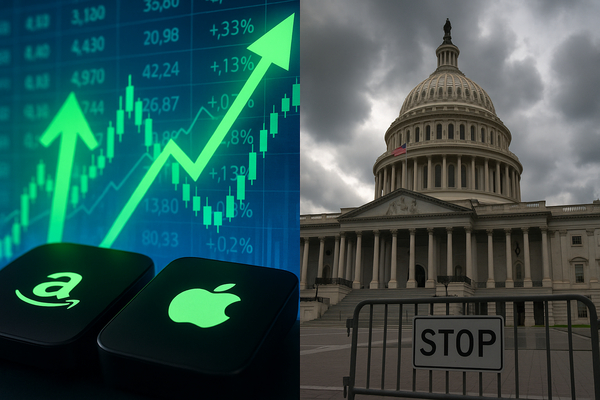
Tech leaders NASDAQ:AMD, NASDAQ:NVDA, NYSE:SHOP and NASDAQ:APP enter a packed week where earnings, AI partnerships and valuation debates will move markets. Short term, earnings headlines and Nvidia’s recent South Korea deal are driving flows and volatility. Longer term, secular AI demand, cloud adoption and digital commerce growth remain the core growth drivers across regions — from U.S. hyperscalers to Asian manufacturers and emerging-market app ecosystems. Comparatively, Nvidia’s scale is unmatched, AMD is wrestling with margin and valuation questions, Shopify remains a durable commerce play, and AppLovin shows high-growth metrics. The timing matters now because multiple earnings releases and a major sovereign-AI pact compress catalysts into days, raising tradeable event risk.
Earnings calendar: three reports compress near-term risk
AMD (NASDAQ:AMD) is set to report within seven days on 2025-11-04. The stock closed at $256.12 and carries a strong technical score (100.00) and a solid fundamental score (68.30). Analysts show a wide range of views — a mean price target of $245.38 and a median of $247.86 — reflecting debate over upside vs. margin pressure. Recent coverage flagged strong Q2 growth in gaming and client, but warned margin pressure and AI competition could weaken the near-term risk-reward.
Shopify (NYSE:SHOP) also reports within the next seven days on 2025-11-04. SHOP closed at $173.86. Analysts’ mean target sits near $165.96 with a median of $168.30. News flow recently described Shopify as an “unstoppable growth stock” for 2026, reinforcing the growth narrative, but investors will parse margins and merchant metrics this quarter.
AppLovin (NASDAQ:APP) is scheduled to report on 2025-11-05. APP closed at $637.33 and shows a higher RSI (69.94) and wide analyst targets (mean $666.86, median $696.66). Multiple October stories highlighted AppLovin’s growth attributes and insider alignment — near-term figures will test whether monetization and user economics keep pace with lofty expectations.
Nvidia’s sovereign-AI deal changes regional dynamics
NASDAQ:NVDA announced a major partnership with South Korea, alongside Samsung, SK Group, Hyundai, LG and NAVER to deploy an estimated 260,000 GPUs. Nvidia closed at $202.49 and shows a robust technical score (88.44) and top-tier fundamental score (85.00). Sentiment remains high (96.00).
This deal accelerates local AI infrastructure buildouts in Asia and signals governments and large conglomerates are prioritizing sovereign compute. For global markets, it tightens Nvidia’s lead in AI acceleration and could shift procurement timelines for cloud providers and enterprises in Europe and the U.S. Historically, infrastructure-scale commitments have amplified vendor revenues across multiple quarters; the scale here suggests sustained demand rather than a one-off purchase.
Technical, analyst and sentiment picture: where the market stands
Momentum readings are mixed. AMD’s RSI 57.26 sits in neutral territory with 50-day EMA/SMA at 163.27/166.00 and a 52-week range of $76.48–$267.08. NVDA’s RSI 63.19 and the stock’s YTD gain of $64.18 from a 2025 start of $138.31 underline investor enthusiasm.
Analyst positioning diverges. NVDA posts an analyst score of 100.00 from 60 analysts with aggressive buy-side positioning and a mean target of $225.37. AMD’s analyst score is 57.14 based on 47 analysts and shows a wider mix of recommendations, while AppLovin and Shopify display more bullish broker sentiment but also wide target bands.
Sentiment and trade-engine metrics favor NVDA and AMD: NVDA trade engine 81.91, sentiment 96.00; AMD sentiment 100.00, trade engine 71.47. AppLovin sentiment is healthy (83.00) and Shopify more muted (62.00). Technical and sentiment alignment suggests NVDA still leads momentum flows, while AMD and APP face nearer-term event risk around earnings.
Fundamentals, valuation and scenarios to watch
Growth and capital allocation profiles differ. NVDA posts top scores for growth (100.00), profitability (100.00) and strong capital allocation (65.02%). AMD shows high growth (94.97%) but lower capital allocation (18.44%) and mid-level profitability (51.36%). AppLovin and Shopify both score high on growth metrics — APP growth 91.76%, SHOP growth 87.45% — yet show weaker profitability and mixed capital allocation.
Valuation markers are notable. All names sit in a market where forward expectations vary widely. AMD’s price targets span $135.54–$325.50 (mean $245.38). APP ranges $360.57–$903.00 (mean $666.86). NVDA’s band is $101.00–$409.22 (mean $225.37). This dispersion reflects differing views on AI upside, margin resilience, and competitive pressure.
What to monitor next: (1) quarter-to-quarter revenue and margin beats or misses in the upcoming reports for AMD, SHOP and APP; (2) commentary on AI product cadence, data-center pricing and capacity from AMD and Shopify’s guidance on merchant trends; (3) execution details and timeline from Nvidia’s South Korea pact and whether it precipitates supply-chain or pricing implications for peers. Investors should weigh near-term event risk against longer-term structural demand for AI, cloud and digital commerce.
Disclosure: This report is informational and not investment advice.








